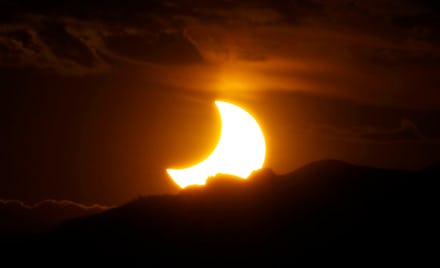Why it’s crucial for Californians to turn off their lights during the upcoming solar eclipse

On Monday, August 21, the United States will experience its first solar eclipse in 99 years.
If you want a very in-depth explanation of what actually goes down during a solar eclipse check out Mic’s guide, but as NASA eloquently defines, an eclipse is when “one heavenly body, such as a moon or planet, moves into the shadow of another heavenly body.”
And while that shadow will produce a once-in-a-lifetime view for millions of Americans from coast-to-coast it will also wreak just a little bit of havoc on clean energy lovers in California.
During the eclipse, northern California will see 76% of the sun’s rays blocked by the moon, while southern California will see 62% of the sun’s rays blocked, according to Cal Eclipse.
During the eclipse, the site explained, solar system generation in the state is expected to go from 64% to 83% capacity at the start of the eclipse to 15% to 37% capacity at its height around 10:22 a.m. and then return to normal capacity once it is over. However, during the eclipse, Bloomberg noted, more than 9,000 megawatts of solar power may go down across the country, which is the equivalent of about nine nuclear reactors and is enough to generate power for about 7 million homes. Steven Greenlee, spokesman for California’s grid operator, told Bloomberg that the state will need to fill a gap of about 6,008 megawatts.
So to help out solar energy consumers during the height of the eclipse the California Public Utilities Commission is asking all Californians to do one simple thing: Turn off their lights.
“We have plenty of wind, geothermal, hydro and natural gas to make sure the grid runs smoothly during the solar eclipse, but we also have a lot of Californians who want to do their California thing and step in to help replace the sun when it takes a break,” Michael Picker, CPUC president, said in an email statement.
To help combat potential energy loss, and to further educate the public on energy consumption year-round, the Cal Eclipse site encourages people to take a pledge stating they will not use excessive energy during the eclipse. It asks people to turn off their lights, switch bulbs to LED, unplug electronics and overall use less electricity all day. Beyond saving solar energy, Picker noted, it will also help Californians reduce their greenhouse gas emissions.
In reality, the CPUC isn’t worried about the eclipse in terms of energy consumption or any potential blackouts in the Golden State. In fact, they’ve been planning for the impending celestial event for more than a year, taking many lessons from the 2015 eclipse in Europe and ensuring the Independent System Operator has about 200 megawatts of reserve power ready to roll from small natural-gas power plants, according to the San Francisco Chronicle.
Instead, the CPUC is taking this wildly popular event as an opportunity to further educate citizens about the state’s green energy goals and informing the public on how they can help the state reach them.
“California has one of the most ambitious renewable energy programs in the nation,” Terrie Prosper, CPUC’s Director News and Outreach Office, explained via email.
Prosper added that the program will require 50% of the power that utilities sell annually to come from renewable sources by 2020. To help hit this goal, Prosper pointed to the California Solar Initiative and Self-Generation Incentive Program, which both helped spur adoption of solar and other technologies by providing rebates and tax incentives for California citizens.
Moreover, all the things the CPUC is asking the public to do on eclipse day is just plain good advice. As the CPUC explained in a press release, 23% of the electricity used to power home electronics is consumed while the products are turned off. According to the Natural Resources Defense Council, this “vampire energy” adds up to about $100 per year per household to power devices while they are off or in standby mode.
Moreover, if all Californians upgraded to LED light bulbs the state could reduce CO2 emissions equivalent to those produced by a coal-fired power plant in one year. Doing so will also save households even more hard-earned cash because LED light bulbs use at least 75% less energy than their traditional counterparts and last 25 times longer. By replacing five of the most frequently used light fixtures in their homes, the CPUC said people can save $70 each year in energy costs. As Picker said, “When we come together to do one small thing to reduce energy usage, we can have a major impact on our environment.”